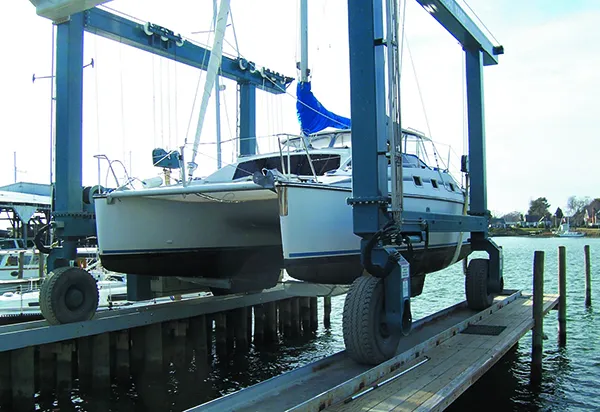Without proper testing, calculating stability yields only a rough picture.

impact on stability.
Evaluating multihull performance based on design numbers is a bit more complicated than it is with ballasted, displacement monohulls, whose speed is generally limited by hull form. [Editor’s note: The formula for Performance Index, PI has been updated from the one that originally appeared in the February 2021 issue of Practical Sailor.
The following definitions of units apply to the adjacent table:
SA = sail area in square feet
D (displacement) = weight in pounds
LWL = length of waterline in feet
HCOE = height of sail center of effort above the waterline in feet
B = beam in feet
BCL = beam at the centerline of the hulls in feet.
Since a multihull pivots around the centerline beam, the overall beam is off the point and is not used in formulas. Calculate by subtracting the individual hull beam from the overall beam.
SD ratio = SA/(D/64)^0.66
This ratio gives a measure of relative speed potential on flat water for monohulls, but it doesn’t really work for multihulls.
Bruce number = (SA)^0.5/(D)^0.333
Basically this is the SD ratio for multihulls, it gives a better fit.
Performance index = (SA/HCOE)^0.5 x (D/1000)^0.166
By including the height of the COE and displacement, this ratio reflects the ability of the boat to use that power to sail fast, but it understates the importance of stability to the cruiser.
Stability factor = 9.8*((0.5*BCL*D)/(SA*HCOE))^0.5
This approximates the wind strength in knots required to lift a hull and includes a 40% gust factor. In the adjacent data sheet, we compare the formula’s predicted stability to observed behavior. Based on our experience on the boats represented, the results are roughly accurate.
Ama buoyancy = expressed as a % of total displacement.
Look for ama buoyancy greater than 150% of displacement, and 200 is better. Some early trimaran designs had less than 100 percent buoyancy and would capsize well before flying the center hull. They exhibited high submerged drag when pressed hard and were prone to capsize in breaking waves.
Modern tris have ama buoyancy between 150 and 200 percent of displacement and can fly the center hull, though even racing boats try to keep the center hull still touching. In addition, as a trimaran heels, the downward pressure of wind on the sail increases, increasing the risk of capsize. The initial heel on a trimaran is more than it is on catamarans, and all of that downward force pushes the ama even deeper in the water. Thus, like monohulls, it usually makes sense to keep heel moderate.
These numbers can only be used to predict the rough characteristics of a boat and must be supplemented by experience.

































